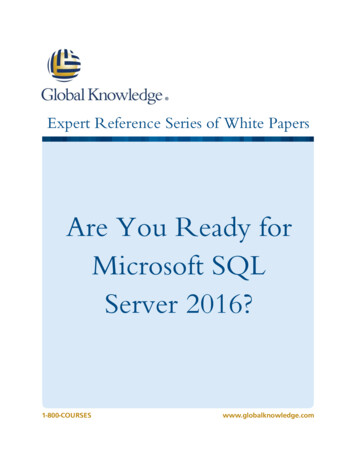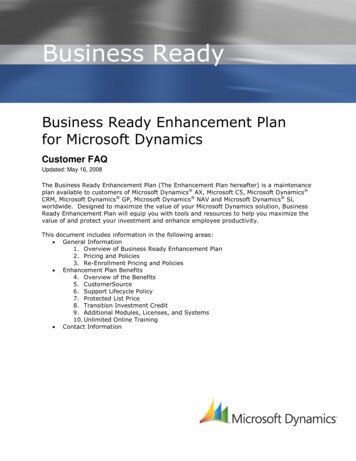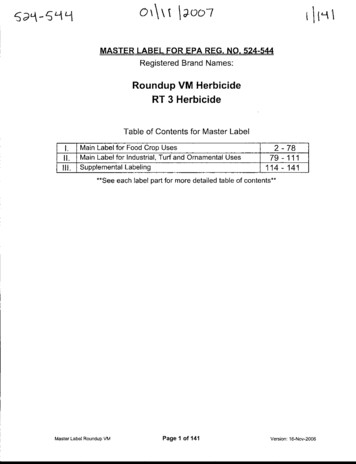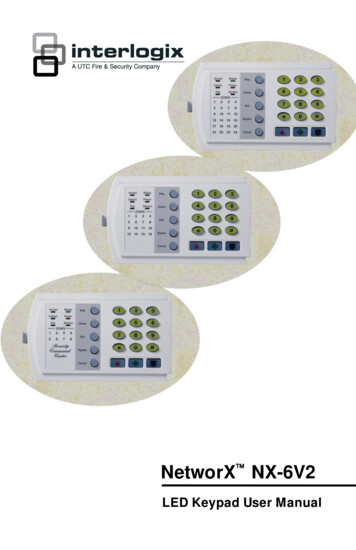
Transcription
Expert Reference Series of White PapersAre You Ready forMicrosoft SQLServer 2016?1-800-COURSESwww.globalknowledge.com
Are You Ready for Microsoft SQLServer 2016?Brian D. Egler, Global Knowledge Course Director, MCITP, MCSE, MCTIntroductionAre you ready to explore Microsoft SQL Server 2016? In this white paper we will examine three key new featuresthat show how SQL Server 2016 provides automatic end-to-end security, seamless generation of businessanalytics, and elastic integration of data in the cloud.Global Knowledge is the worldwide leader in IT and business training, delivering hands-on education via trainingfacilities, private facilities, and the Internet, enabling our customers to choose when, where, and how they wantto receive training programs and learning services. Keep an eye on the Global Knowledge website for details.Microsoft SQL Server 2016 ThemesThree underlying themes categorize the SQL Server 2016 release: Mission Critical PerformanceDeeper Insights Across DataHyperscale CloudWithin this white paper, we will be exploring one selected new feature under each theme to get a sense of thecapabilities of the new release. Other features, while too numerous to describe here, are documented on theMicrosoft website. You can also download an evaluation copy of the software from the same location. Of course,all the functionality of Microsoft SQL Server 2016 will be contained in the Microsoft Official Curriculum (MOC)courses offered by Global Knowledge both in the physical and virtual classroom platforms when available.Mission Critical PerformanceSelected Feature: Always EncryptedStarting with SQL Server 2005, Microsoft allowed column-level encryption natively within the database engine.Sensitive columns could be encrypted by an application and decrypted as needed providing an “end-to-end”security option. Selected columns would be encrypted on disk, on backup, in memory, and over the network.However, column-level encryption required application code changes to use functions such as EncryptByKey andDecryptByKey. A Database Encryption Key and an appropriate Certificate were needed to be accessible forencryption or decryption to occur successfully. With SQL Server 2008, Microsoft introduced Transparent DataEncryption (TDE) as a feature that would automatically encrypt a whole database without having to changeapplication code even for third-party applications. A major benefit was that the “data at rest” would beencrypted, including database files on disk and backups on tape or disk. This feature provided additional securityto counter possible physical security vulnerabilities. However, as soon as data was “in motion,” for instance, intomemory or over the network, the information was automatically decrypted and therefore not protected.Copyright 2015 Global Knowledge Training LLC. All rights reserved.2
Now with SQL Server 2016, Microsoft has implemented an “Always Encrypted” option which includes end-to-endencryption without the need for application code changes therefore providing a best-of-both-worlds solution. Amajor benefit of this strategy is that Always Encrypted provides a separation between users who own the dataand users who manage the data, such as administrators, because the encryption/decryption occurs at the clientlayer. With the advent of cloud-based data, this separation is especially important. A Column Master Key (CMK)and Column Encryption Key (CEK) are required to be accessible for encryption or decryption to occur successfullyusing an Always Encrypted-enabled driver installed on the client computer.Although the application code does not need to change, the data definitions for sensitive columns will need to beredefined to include the ENCRYPTED WITH clause (see Figure 1).Figure 1: CREATE TABLE Example for “Always Encrypted”The ENCRYPTION TYPE clause for a column can be DETERMINISTIC or RANDOMIZED. The DETERMINISTIC settingmeans that, given a certain input data, the encrypted data will always be the same output. This option allowsgrouping, filtering, joining, and indexing with encrypted values. However, it may provide an opportunity forunauthorized users to deduce data for columns with few distinct values. The RANDOMIZED setting provides moresecurity by encrypting in a less predictable way; however, it does not provide support for grouping, filtering,joining, and indexing with encrypted values.Copyright 2015 Global Knowledge Training LLC. All rights reserved.3
Two types of encryption keys are required for encryption: A Column Encryption Key (CEK) and a Column MasterKey (CMK). The CEK is used to perform fast, synchronous data encryption while the CMK is used to encrypt theCEK asynchronously for high security. The CMK must be available in a Trusted Key Store, typically using aCertificate, on the client machine. See Figure 2 for an example of Column Encryption Key Properties within SQLServer Management Studio (SSMS).Figure 2: Column Encryption Key PropertiesCopyright 2015 Global Knowledge Training LLC. All rights reserved.4
Once the appropriate keys and certificates are available and authorized to a client, a special connection stringoption needs to be specified, namely, “Column Encryption Setting Enabled” (see Figure 3).Figure 3: Always Encrypted Application Authorized AccessCopyright 2015 Global Knowledge Training LLC. All rights reserved.5
If any of the required objects are inaccessible or unauthorized, decryption will not occur and data values will bepresented as encrypted, assuming the user has security permissions on the data columns themselves (see Figure 4)for an example where decryption is unauthorized but a user, such as an administrator, has access permissions.Figure 4: Example Data Access without Decryption AuthorizationAlways Encrypted is therefore a mission-critical feature of Microsoft SQL Server 2016 for both “on-premises” and“cloud-based” data that require an automatic and transparent end-to-end security solution.Deeper Insights Across DataSelected Feature: Temporal DataWhen comparing the differences between operational systems and business intelligence (BI) solutions, wetypically see that the operational viewpoint is that of the current, latest data values whereas the importance of BIprovides the ability to analyze historical trends and patterns of data changes over time. A common way ofsupporting historical analysis in a BI solution is by defining a Slowly Changing Dimension (SCD) in the DataWarehouse (DW) design. The DW provides a historical database as the foundation for business analysissupporting Facts and Dimensions in a “Dimensional Model.” Facts are typically numeric values that are used toassess the business, such as revenue, costs, profits, salaries, etc. Dimensions add context to the analysis of facts,for instance, analyzing revenue by region or profits by year or average manager salary by department. In theseexamples, region, year, and department would be dimensions in the DW with revenue, profits, and salaryimplemented as facts. Consider when a new manager is assigned to a department, should their salary be appliedto the whole year average or only the time period that they were assigned? If we choose the former, we aredefining an “SCD Type 1,” which only stores current data values and the potential for inaccurate detailed analysis.For accurate analysis over time periods, we must choose the latter option, which requires the careful design of an“SCD Type 2” for historical data. The typical design method of an SCD Type 2 is to provide the ability for multiplerows for a given dimension member to allow for storage of historical changes by the addition of a “surrogate”key. The surrogate key provides uniqueness and allows duplicate values of the business key used in theCopyright 2015 Global Knowledge Training LLC. All rights reserved.6
operational system. Typically added also, would be a start date/time and an end date/time column for accuratetime analysis. The design and population of this type of dimension is usually a complex, manual, time-consumingprocess. Now in SQL Server 2016, we have the option of Temporal Data, which automates this process via systemtables and is part of the ANSI SQL 2011 specification.Temporal Tables, also known as “system-versioned tables,” can be defined in any database and will automaticallytrack data changes with start and end date/times. The temporal table actually consists of two tables, the currenttable that shows the latest data values and a history table, which shows the previous changes and when theywere current. See Figure 5 for an example of a temporal table definition.Figure 5: Temporal Table Creation ExampleOnce created, the temporal table will automatically track changes and maintain the start and end date/timecolumns, effectively implementing an SCD Type 2 via the history table while keeping the current table as normalwith the latest data values. Both tables are visible in the SSMS Object Explorer (Figure 6) and can be queried asseparate tables, as required.Copyright 2015 Global Knowledge Training LLC. All rights reserved.7
Figure 6: Temporal Table in Object ExplorerNotice that the current table represents the latest data only with the SysEndTime column set to the maximumvalue for datatype datetime2 to indicate current values. See Figure 7.Figure 7: Temporal Data - Current Table QueryAlso notice that that the history table represents the previous updates with the SysStartTime and SysEndTimecolumns representing the period of time that those data values were current. Figure 8 shows that theDepartmentNumber “3” row has been updated three times after initial insertion. Temporal data can be used forauditing or for recovering data values after accidental updates but most importantly can be directly copied to anSCD Type 2 dimension table in a Data Warehouse without manipulation, saving complex processing whenincrementally loading data.Copyright 2015 Global Knowledge Training LLC. All rights reserved.8
Figure 8: Temporal Data - History Table QueryHyperscale CloudSelected Feature: Stretch DatabaseMicrosoft’s transition to a cloud-computing, services-based company has been rapid and largely successful withmajor services such as Office 365 and Azure leading the way. Cloud-based databases provide increased flexibilityand “elastic” scalability, ideal for rapidly growing organizations. There are still many evolving security-basedquestions, but some data may be appropriate to host in the cloud and synchronize with sensitive “on-premises”data. This distributed approach to our data is a growing trend in the industry. Microsoft is at the forefront of thistechnology with its Azure platform supporting Azure SQL Database in the cloud and also Azure Virtual Machines(VMs), which can support the full version of SQL Server, if needed. Once again, ease of use and lower costs areMicrosoft’s value propositions. Azure SQL Database is now compatible with SQL Server 2016 and supports a newhybrid option called the “Stretch Database.”Figure 9: Stretch Database ConceptCopyright 2015 Global Knowledge Training LLC. All rights reserved.9
The Stretch Database concept is designed for a database that has large historical tables that are required forquery access but in an infrequent manner. The objective is to store the most frequently accessed tables locallywith the occasionally accessed historical tables off-loaded to the cloud, reducing local storage costs and resourcedemands. Application queries require no changes providing a transparent implementation.The Stretch Database consists of a local database hosted by an on-premises instance of SQL Server 2016 and aremote database hosted by Azure SQL Database (V12 and above). Large historical tables can be identified as“stretch tables” making the data “eligible” for migration to the remote database. The stretch tables are fullymigrated over time to the remote database, however, migration can be paused and resumed as required tooptimize available network resources. Fail-safe mechanisms are built in so that no data loss will occur duringmigration including automatic retry functionality. Again, existing queries can remain unchanged both during andafter migration as the query optimizer understands the current state of migration. Effectively, a stretch tableconsists of a local table with eligible data and a remote table with migrated data. After full migration, the localtable will be empty and the remote table will contain all the data. Any new rows added to the local table willthen become eligible for migration. A stretch-enabled table does not support update or delete operations.In order to allow a stretch database to be hosted by a SQL Server 2016 instance, the “remote data archive”option must be turned on by using sp configure. Then the required database can be enabled for stretchoperations using the appropriate task wizard in SSMS. See Figure 10.Figure 10: Enable Database for StretchCopyright 2015 Global Knowledge Training LLC. All rights reserved.10
Once the Enable Database for Stretch wizard starts, it prompts for the Azure subscription and sign-in credentialsthat should be used for the remote database server. The wizard creates a linked server definition to the remoteAzure SQL Database for secure access. See Figure 11.Figure 11: Stretch SettingsWhen the database is enabled for stretch operations, you can enable selected stretch tables within the databaseusing the Enable Stretch option in SSMS. Again, occasionally accessed historical data tables would be idealcandidates for stretch tables. See Figure 12.Figure 12: Enable Stretch TableCopyright 2015 Global Knowledge Training LLC. All rights reserved.11
Once enabled, the stretch table will begin migration of data from the local table store to the remote table store.The migration can be paused and resumed as necessary to control network usage. Application queries against thestretch-enabled table remain unchanged, however, the query optimizer will create an execution plan thatincludes access to the local table and the remote table combined. (See Figure 13) Therefore regardless of thecurrent state of migration, the correct data will be returned by the query. Over time, the entire table data will bemigrated to the remote table-store freeing up storage and resources for the more active local, non-stretch tables.The stretch table will be available for occasional access as needed however, it must be noted that performance ofremote queries against stretch tables will be slower than the access to local high-performance non-stretch tables,by design. As always, performance metrics must be assessed for acceptability to established service-levelagreements.Figure 13: Query Plan for a Stretch TableCopyright 2015 Global Knowledge Training LLC. All rights reserved.12
You can interrogate the system catalog for information regarding stretch databases and tables using new systemcatalog views and dynamic management objects as shown in Figure 14.Figure 14: System Catalog Views for Stretch DatabasesCopyright 2015 Global Knowledge Training LLC. All rights reserved.13
The remote Azure SQL database, associated linked-server definition, remote endpoint, and appropriate Azurefirewall settings are created automatically when the selected database is enabled as a Stretch Database. SeeFigures 15 and 16.Figure 15: Linked Server Definition for Remote DatabaseFigure 16: Azure SQL Database for Remote DatabaseWith features such as this, Microsoft has successfully incorporated the cloud as an extension of the SQL Serverarchitecture, rather than as a completely separate platform, and as such is allowing customers to leverageexisting technologies in what is being termed the hybrid cloud.ConclusionMicrosoft SQL Server 2016 has some great new features that will allow you to develop high-performing, moresecure, scalable applications using the hybrid cloud. The fact that the features are largely incremental in natureshould reassure users that Microsoft is building on the established foundation of SQL Server 2012 and 2014. Usingsimilar architecture and management tools, customers will be able to smoothly upgrade their systems and skillsbased on the need for the new features, according to their own schedule.Copyright 2015 Global Knowledge Training LLC. All rights reserved.14
Learn MoreLearn more about how you can improve productivity, enhance efficiency, and sharpen your competitive edgethrough training.MCSA: SQL Server 2012 Boot CampMCSE: Data Platform Boot CampMCSE: Business Intelligence Boot CampVisit www.globalknowledge.com or call 1-800-COURSES (1-800-268-7737) to speak with a Global Knowledgetraining advisor.About the AuthorBrian Egler is a Global Knowledge instructor and course director specializing in Microsoft SQL Server technologies.He currently resides in Highlands, North Carolina.Copyright 2015 Global Knowledge Training LLC. All rights reserved.15
technology with its Azure platform supporting Azure SQL Database in the cloud and also Azure Virtual Machines (VMs), which can support the full version of SQL Server, if needed. Once again, ease of use and lower costs are Microsoft's value propositions. Azure SQL Database is now compatible with SQL Server 2016 and supports a new











